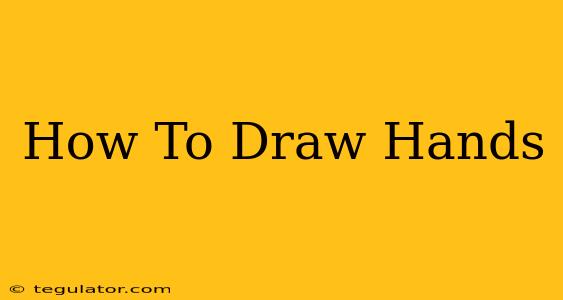Drawing hands is notoriously difficult, even for experienced artists. They're complex, expressive, and deceptively tricky to capture accurately. But don't despair! With practice and the right techniques, you can master the art of drawing realistic and expressive hands. This guide will walk you through the process, from basic shapes to adding intricate details.
Understanding Hand Anatomy: The Foundation of Realistic Drawing
Before diving into the drawing process, it's crucial to understand the basic anatomy of a hand. This knowledge will help you draw hands more accurately and convincingly.
Key Elements to Observe:
- Palm: The fleshy base of the hand. Think of it as a flat, somewhat rectangular shape.
- Fingers: Notice the gradual tapering of each finger from the knuckle to the tip. Each finger consists of three segments (phalanges), except for the thumb, which has two.
- Thumb: The thumb is unique and highly mobile, capable of opposing the other fingers.
- Knuckles: These are the joints that connect the finger segments. Observe their position and how they affect the overall shape of the hand.
- Wrist: The connection point between the hand and forearm. Observe its shape and how it subtly changes depending on the hand's position.
Step-by-Step Drawing Process: From Simple Shapes to Detailed Rendering
Let's break down the process into manageable steps:
Step 1: Simplify with Basic Shapes
Start by sketching the hand using simple geometric shapes. Think of the palm as a rectangle or trapezoid, and the fingers as elongated cylinders or rectangles. This helps establish the overall proportions and structure. Don't worry about details at this stage; focus on getting the basic forms right.
Step 2: Refine the Structure
Once you have the basic shapes in place, begin refining the outline of the hand. Pay attention to the curves and angles of the palm, fingers, and knuckles. Gradually add more details, such as the slight bulges and depressions of the muscles and tendons.
Step 3: Add Details and Shading
Now it's time to add details such as fingernails, wrinkles, and creases. Observe how light and shadow interact with the hand's surface. Use shading to create depth and volume, making the hand appear three-dimensional. Focus on where the light source is coming from and how it affects the shadows.
Step 4: Practice Makes Perfect
The key to mastering hand drawing is consistent practice. Try drawing your own hands from various angles and positions. Use reference photos, paying close attention to the subtleties of form and shadow. Don't be afraid to experiment with different drawing tools and techniques.
Tips and Tricks for Drawing Hands
- Use References: Having reference photos is invaluable. Look at photographs of hands in different poses and lighting conditions.
- Practice Regularly: Consistent practice is key to improving your skills. Set aside time each day to sketch hands.
- Start Simple: Don't try to tackle complex poses right away. Begin with simple hand positions and gradually increase the difficulty.
- Break Down the Hand: Instead of trying to draw the entire hand at once, break it down into smaller, more manageable parts (palm, fingers, thumb).
- Focus on Gesture: Before getting bogged down in details, focus on capturing the overall gesture of the hand. This will provide a strong foundation for your drawing.
Beyond the Basics: Exploring Different Styles and Techniques
Once you feel comfortable with the fundamental techniques, you can explore different styles and techniques, such as:
- Cartoon Hands: These are simplified, stylized versions of hands that are often used in animation and comics.
- Realistic Hands: These aim to accurately depict the anatomy and details of a hand.
- Expressive Hands: These emphasize the emotional aspect of hand gestures.
By following these steps and practicing consistently, you can significantly improve your ability to draw hands. Remember, patience and perseverance are key! So pick up your pencil and start drawing!

